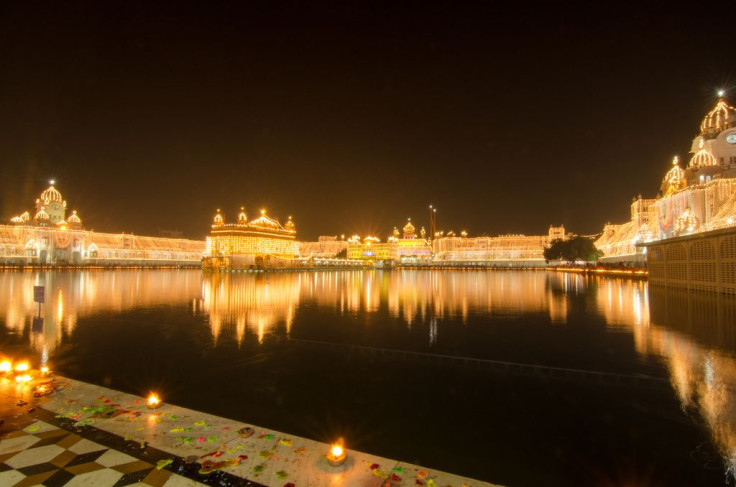Guru Nanak's Birthday 2014: 3 Things You Need To Know About The Sikh Holiday

On Thursday, Sikhs around the world will be celebrating the birth of the faith’s founder, Guru Nanak. His teachings, along with those of the nine other Sikh Gurus that followed him, provide the basis for the religion.
Guru Nanak's birthday is especially celebrated in India and Pakistan, where parades take place. More than 3,000 Sikhs are expected to gather in Nankana Sahib in northeastern Pakistan, Guru Nanak's birthplace and popular Sikh pilgrimage site. Security measures in the area have been heightened after a suicide attack killed more than 60 people at the Wagah border post on Nov. 2.
In the West, parades take place in areas with large Sikh populations. This year, two large Sikh festivals took place in Yuba City and Fresno, California.
For those unfamiliar with the celebration, below are three answers to common questions surrounding the Sikh holiday.
Who was Guru Nanak?
Guru Nanak's birthday is one of Sikhism’s most important holidays. It celebrates the life of the guru who was born in 1469 and at the age of 30, mysteriously disappeared for three days and returned practicing the Sikh faith. It was during this time Sikhs believe God – known as Vāhigurū – revealed himself to the Guru and enlightened him. When he returned, the Guru traveled extensively sharing his message of God, and gained followers. Today, Sikhism is considered the fifth-largest organized religion in the world, with 25 million members.
“It is important to understand that Guru Nanak did not set on his travels to start a new religion,” Manjinder Singh, 19, a Sikh, said. He explains that the Guru was spreading the message of equality for all, which includes equality for women and abolishing India’s caste system. One of his most famous sayings is "Na Koi Hindu, Na Koi Musalmaan" -- there is no Hindu and there is no Muslim, all are equal in the eyes of God. “The Sikh religion was born through his teachings and by people following them, not by Guru Ji himself,” Singh said. ("Guru Ji" is another way to refer to the religion's founder.)
What are Guru Nanak’s Teachings?
Guru Nanak had three simple teachings that he would preach: Naam Japo, Kirt Karo and Vand Shako. These translate to: recite God’s name; make an honest living by working hard; and share the fruits of your labor with the needy. He also saw the human race as one, where mankind lived without any distinctions based on birthright, religion or sex.
“For many [the Guru’s birthday], is a profound time to reflect on Guru Nanak's vision of Oneness -- the oneness of the divine and the oneness of humanity -- and his message: ‘I see no stranger,’” Valarie Kaur, an interfaith organizer who is Sikh, said. “If we begin to see the world in this way, it inspires an unending flow of love and compassion -- and also a commitment to seva, or spiritually grounded service.”
Community service is another central tenet of the Guru’s teachings. When the Guru was 12 years old, according to Sikh lore, his father gave him 20 rupees to start a business venture. Rather than starting his own enterprise, the Guru used his money to buy food for the poor, homeless and holy men he saw in the streets.
“That was the start of the free community kitchen, the first of its kind in those times,” Brahmjot Kaur, a website designer and a Sikh in Bangalore, India, said. These free kitchens, known as langar, were later institutionalized by the third Guru, Amar Das.
Today each Sikh community or place of worship, known as a gurdwara, has its own langar institution preparing meals for those in need, Sikh and non-Sikh. Sometimes it is an open-air kitchen, a partitioned area in someone’s home, or a facility designed to serve thousands.
How is the Guru's birthday celebrated?
Typically on the Guru’s birthday, Sikh families will gather at the gurdwara for prayers, food, festivities, and stories on Guru Nanak's life and teachings. Like other Gurpurbs (festivals which celebrate the lives of the Gurus), prayers involve reading the Sikh holy book, the Guru Granth Sahib, continuously from start to finish. This is a nonstop 48-hour recital involving a team of Sikh women and men. Each person reads for two to three hours. The process begins ahead of the Guru’s birthday and ends on the morning of the anniversary. Afterward, there is a singing of hymns.
Parades are another popular form of celebration. Many neighborhoods in India have pre-dawn parades known as parbhat feri, where Sikh communities walk together and sing verses from the Gurus. This is followed by eating and blessing a sweet-tasting food known as Karah Prasad. Celebrations continue well into the evening with fireworks.
Singh said after a meal at his local gurdwara's communal kitchen, he planned on washing the dishes and helping split the leftovers among members of the congregation.
“I know my planned day may not seem ‘fun’ or ‘special’ to others on how they celebrate the birth of an important person in their life, but for a Sikh, any second he can do Sewa (selfless service), listen to the Guru's Bani (teachings) and just be in the presence of the Guru is the most blessed second of his life,” Singh said. “I couldn't think of another way of celebrating the day.”
© Copyright IBTimes 2024. All rights reserved.






















